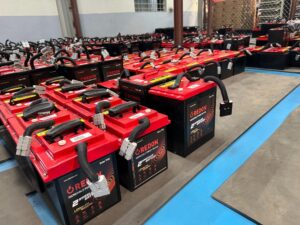Within the field of energy storage, no one has more power than lithium batteries, which drive everything from cell phones to electric vehicles. Conversely, these batteries have wide quality variations, which can be divided into A Grade and B Grade cells as two separate categories. The cycle life of a lithium cell is critical, characterized by the number of charge-discharge cycles until its retention capacity reduces to 80%.
Further digging into their discrepancies is necessary for comprehending subtle points of battery quality and performance. Here, we will delve into the complexities of A Grade and B Grade cells, discussing the key parameters influencing Redon lithium battery production.
Comprehension of A Grade and B Grade Cells
Grade A and B Grade cells are vital parts of the lithium-ion battery ecosystem, which vary in quality and efficiency. A Grade cells commonly have supreme attributes such as higher energy density, better cycle life, and improved safety characteristics.
On the contrary, the B Grade cells will most of the time be deficient in these areas, with their performance levels being lower and their lifespan also being potentially short. The average difference in price between B Grade cells and A Grade cells is approximately 30-40%. These differences are the result of differences in production techniques, quality assurance systems, and material composition.
A Grade vs B Grade: Performance Comparison
In the area of battery manufacturing, the A Grade and B Grade cell distinctions are critical to the determination of overall performance and reliability. We shall go through the key differences between the two lithium-ion cell grades.
Capacity Fade and Life Cycle
The capacity fade in A Grade cells is usually lower than that in B Grade cells as time goes by. It implies that they can sustain a greater percentage of their initial capacity even after many charge-discharge cycles, thus enjoying a prolonged cycle life. On the contrary, B Grade cells might suffer from faster capacity degradation, which reduces the overall lifetime and performance consistency.
Safety and Reliability
Cells of A Grade are subjected to numerous quality control procedures and meet the highest performance criteria, which improves safety and reliability. They are less likely to suffer from problems like bulging, swelling, or abrupt failure; hence, they are preferred for applications where safety is critical, such as in electric vehicles. Quality inconsistencies in B Grade cells may lead to increased safety risks.
Impedance and Charge/Discharge Rates
B Grade cells usually have a higher impedance when compared to A Grade cells, and hence, they have a slower charge and discharge rate. This makes them more suitable for high-power applications such as electric vehicles, where fast charging and discharging are essential. B Grade cells tend to exhibit poor performance when operating under high-stress conditions, resulting in low charge and discharge rates and reduced overall efficiency.
Conclusion
In summary, in the context of lithium batteries, the performance, longevity, and safety differences between A Grade and B Grade cells are enormous. Grade A cells offer the highest level of quality and reliability, which is why they are the favorites in critical applications such as electric vehicles. Grade A cells should be given priority in battery manufacturing to achieve optimal performance and safety. Opt for A Grade cells today for top-quality and dependable energy solutions. Drive into the future with confidence in your batteries’ upgrades!




